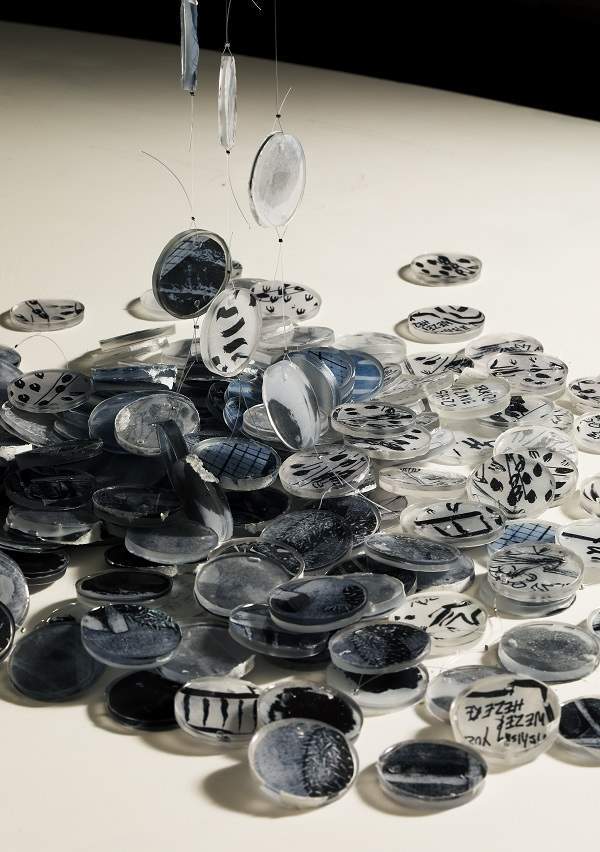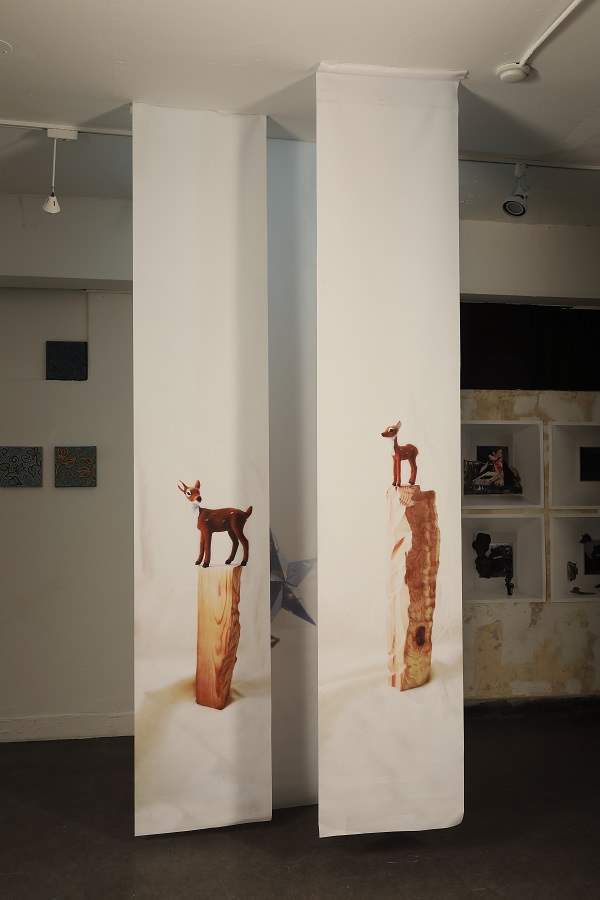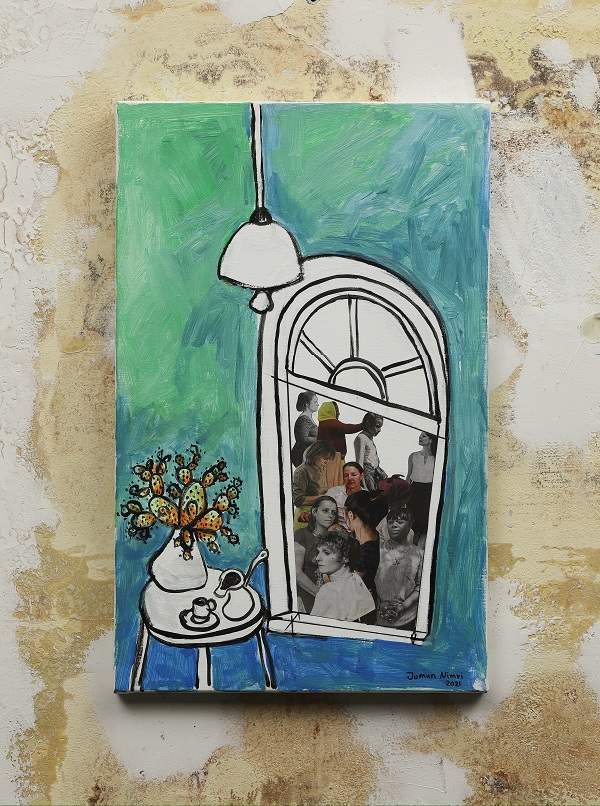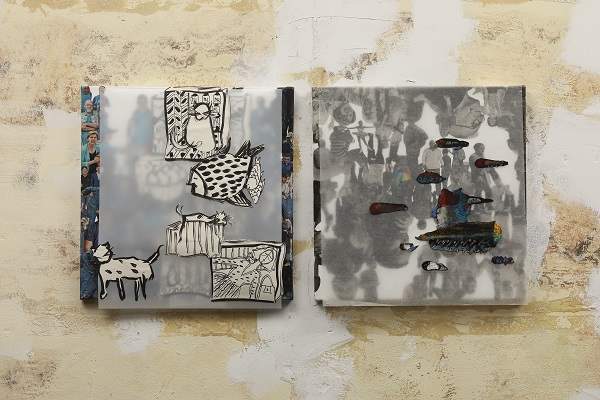AMMAN — Warming hearts up just as winter makes its presence felt are the artworks displayed at Wadi Finan Art Gallery under the name “Layers of time, 4+4”.
اضافة اعلان
Showcasing the works of four Jordanian and four South Korean artists, this cross-cultural group exhibition, the brainchild of artist Se-eun An, could be considered a sequel to a similar event held in Seoul in July and August.
 Artworks on display at Wadi Finan Art Gallery. (Photos: Handouts from Wadi Finan)
Artworks on display at Wadi Finan Art Gallery. (Photos: Handouts from Wadi Finan)
At a time when meeting in person may be difficult, even impossible, An singlehandedly managed the logistics of transporting the works, overseeing their display, and acting as a cultural bridge, all for the sake of bringing together two peoples and showing art for the universal language that it is.
The original idea, detailed in the video that meets the viewers as soon as they enter the gallery, entailed artists from the two countries exchanging partly finished works for the others to complete. The outcome is a stunning collaboration that displays creativity, originality, and universality, yet uniqueness.
Using different media and techniques, and notwithstanding the geographical distance, the final outcome is outstanding works of art that show sensibility, understanding of the other, and a rare consent to collaborate in the act of creation.
 Artworks on display at Wadi Finan Art Gallery. (Photos: Handouts from Wadi Finan)
Artworks on display at Wadi Finan Art Gallery. (Photos: Handouts from Wadi Finan)
Thus, An’s intricate paintings looking like lace doilies come to adorn Samer Tabbaa’s sculptural wood pieces, and his wood sculptures will have Jueun Lee’s paper renditions of dainty deer atop with the whole printed out and hung as an installation. Or his wooden piece will act as an interesting jewelry-display stand for Soojin Kim’s twisted-newspaper ribbon hugging it like a necklace.
Jueun Lee’s flowers are discretely projected against Dina Haddadin’s harsh industrial/architectural landscape, softening it and making one wonder whether the message is about industrialization destroying nature or nature steadily reclaiming its rightful place as man encroaches on.
 Artworks on display at Wadi Finan Art Gallery. (Photos: Handouts from Wadi Finan)
Artworks on display at Wadi Finan Art Gallery. (Photos: Handouts from Wadi Finan)
In one painting, Juman Nimri’s habitual cactus is put in perspective by Soojin Kim’s window through which an eclectic and indifferent crowd can be seen. In other works, the barely hinted-at drawn cacti serve as background for three-dimensional resin-made bottles serving as vases for minimalistic wire outlines of more cacti.
Working with media and concepts unfamiliar at times proved challenging for all artists, as they assert in the video interviews, but they ended up satisfied with and relishing the artistic outcome.
 Artworks on display at Wadi Finan Art Gallery. (Photos: Handouts from Wadi Finan)
Artworks on display at Wadi Finan Art Gallery. (Photos: Handouts from Wadi Finan)
As Soojin Kim succinctly put it, “it was an opportunity for me to grow as an artist.”Whether gaining new perspectives or enjoying the new experience and the collaborative process, each artist put their imprint on the novel outcome, accepted and created a new narrative, and communicated through art pieces, an enriching process both for them and the viewers.
Dodi Tabbaa, Jueun Lee, and Soojin Kim’s collaboration resulted in original photographs displayed hanging like negatives left to develop on a rope. The same print worked over and over creates an animated and crowded world of everyday objects and people performing leisure activities: yoga, jumping, and dancing.
 Artworks on display at Wadi Finan Art Gallery. (Photos: Handouts from Wadi Finan)
Artworks on display at Wadi Finan Art Gallery. (Photos: Handouts from Wadi Finan)
The seemingly enjoyable acts, by force of being repeated, become automated, give the impression of manipulation — by some mysterious power, by life’s demands, or by the requirements of our consumer society.
Watching them may give rise to serious thought, but hearing Minkyung Lee, who uses photography as the primary medium to create installations “that involve people”, one is relieved to see that the artists also had fun working on the project.
An’s works might have inspired the “layering” of concepts involved in this artistic undertaking. Her elaborate patterns are created “by at least 50 layers of paint” that are then painstakingly chiseled away to create sculptural depth and delicate beauty, a somehow arabesque and pointillist imagery that can only hint at the amount of time and effort spent to create it.
An shrugs away the idea of effort. It is clearly a labor of love whose outcome is original, endearing, and comforting.
An likes working with everyday, disposable objects that she sees “similar to our modern-day relationships that are easily established and broken.”Yet, “recently, I have been creating artworks by stacking colors and overlapping paints on canvas. I would later scrap off the paint with a carving knife. By using a method that reveals and digs past actions, I show the layers of time that the work contains. The seemingly inadvertent patterns that appear on the surface of the canvas are the result of carving in different directions and (with different) strengths on the layers of paint. It is the inevitability that comes from the unplanned.”
An exceptional inevitability, no doubt, one that gives off a festive feeling, just right for the holiday season.
For this project, artists shifted focus from creating their own works to recreating those of others. It entailed a meaningful exploration of two cultures without having to travel.
The exhibition runs through January 2.
Read more Culture and Arts



